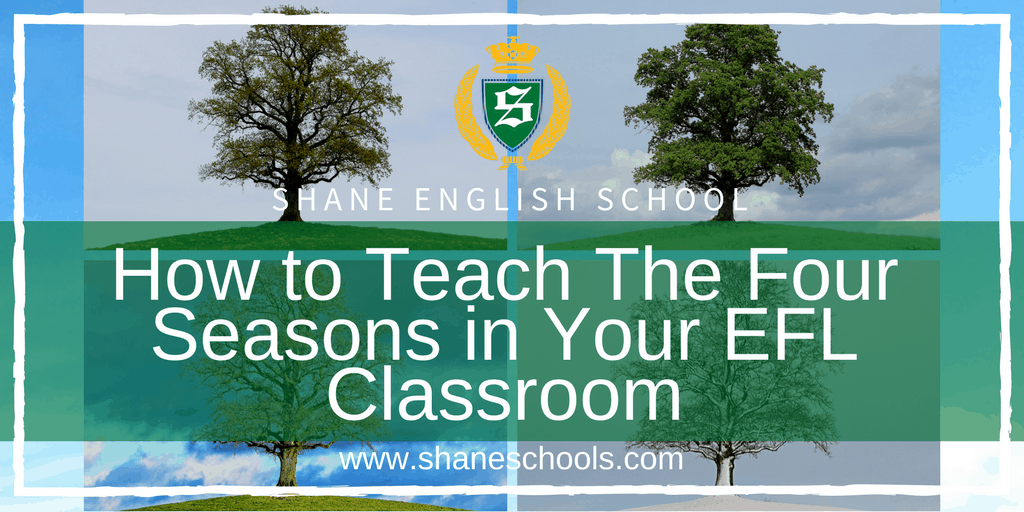We talk about the weather A LOT, so it’s useful for students of all ages to have the skills to discuss weather and the seasons in a variety of contexts. Here are some tips on teaching the seasons to EFL students.
The four seasons are a fun EFL topic for both students and teachers. There is so much to talk about, it is an important part of everyday English, and there are countless activities to make this topic engaging for learners young and old.
Here are four activities to help your students grasp the concept and practice using this new set of vocabulary in a variety of ways.
1. Start With The Basics
To teach your students about the seasons, you first need to explain the four seasons. Use pictures to describe each seasonal change such as piles of dry leaves for autumn, snow for winter, the beach for summer and cherry blossoms for spring (or some local springtime flower).
Once your students understand the concept, you can start teaching them how to spell the four names and using calendar months to explain when each season occurs.
To end off the activity, go around and ask your students which season is their favourite and why. For younger students, you can also ask them to draw their favourite season in their workbooks.
You can also suggest some of our language learning tips here and here.
2. What Happens in Each Season
Apart from the temperature changing, various other things happen when the seasons change. To help your students discuss the things they see in each season and form complete sentences, teach them what objects or things happen under each category.
For example, in autumn there are pumpkins and dry leaves, and in winter there is snowflakes and snow. Make a list of the new vocabulary and spend a lesson teaching it to your students and arranging it under the different seasons.
Once you are confident in their abilities, split the class into teams for large classes or ask your students to sit in a large circle. Explain that you will choose a season and they need to complete the following sentence structure: “I see ___ in spring.” You can use a ball toss to select the next student or just have the students work around the circle systemically.
It is a great way to help your students expand their vocabulary and start using what they have learned in complete sentences.
3. What to Wear
With a change of season, comes a change in attire. If you have already taught your students about the different types of clothing items, this is a fun way to review their vocabulary while putting it into a new context. (For specific summer vocabulary review, check this out.)
Before starting this activity, discuss with your class which type of apparel goes under which season and why. Once you are confident your students have grasped the concept, try this fun twist on a board snap game to test their knowledge:
Step 1: Create labels for each season and a picture to depict each one underneath. Stick these on the board.
Step 2: Create flashcards with clothing items from each season and arrange them mixed up on the board as well.
Step 3: Divide your students into teams and explain that you will call out a season and then each team member will have one chance to select an item and put it under the right heading.
You can play the round until all the clothing items are put under the right category, or to up the stakes, you can play against the clock.
4. What Holidays Take Place in Each Season
One of the best parts about learning about the seasons is being able to incorporate it with holidays and the weather.
To begin, brainstorm with your students a list of holidays they are familiar with. If you want, you can separate local holidays like Chinese New Year and Songkran from traditional Western holidays like Thanksgiving or Halloween that are not celebrated in the country.
Once you have your list, ask your students to separate the holidays by season. If your students have already learned about weather, you can use this activity as an opportunity to go over vocabulary by asking your students to describe the type of weather associated with each holiday. For example, winter is cold; there is a lot of snow, or maybe heavy rains depending on the region.
To end off the lesson, ask your students to discuss their favourite holiday and what season it falls in. For homework, you could ask your students to interview their parents and friends to find out their favourite holiday and season.
Why Students Need To Know About The Four Seasons
EFL students need to know about the four seasons for everyday conversation. As much as English speakers love to complain about how bland talking about the weather is, it is something that still dominates our conversations, holiday plans and outdoor activities.
Travellers might ask about the weather in their country or even advice on what to wear at certain times of the year. So having a solid understanding of the seasons is a must-have for any EFL student.
Use these activities to engage your EFL learners and help them understand this topic while having fun at the same time.
Want to continue taking your teaching to the next level? Read more of Shane English School’s Teaching Tips.
About the Author
Lauren Melnick is a South African travel blogger and ESL teacher currently living in Ubon, Thailand. When she isn’t making lesson plans and watching nursery rhymes on YouTube, you can find her eating up a storm, taking selfies with dinosaurs, and planning her next adventure.
Follow her travels on Wanderlust Movement, Facebook, Twitter, and Instagram.

We're hiring!
With schools around the world, Shane English School always has exciting new opportunities to offer.


